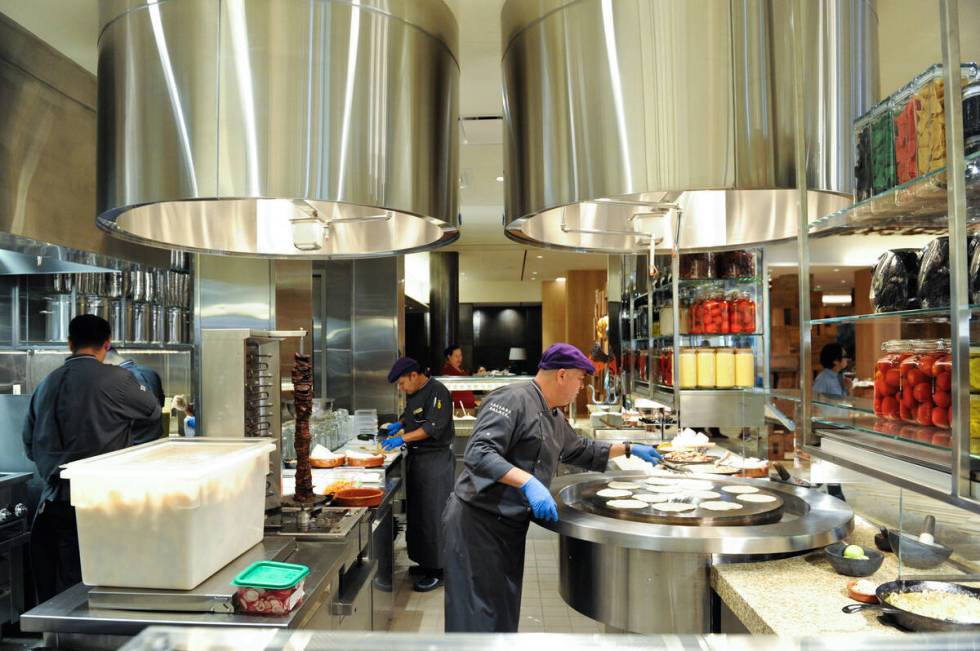Bargain to Bacchanal: Why you don’t see under-$10 buffets in Las Vegas anymore

What happened to the under-$10, all-you-can-eat buffet?
Buffets, along with slot machines and mega-resorts, have long been synonymous with Las Vegas’ history, but gone is the era of $5 entry to all-you-can-eat buffets, or every casino on the Strip having its own buffet in general.
But, where did the all-you-can-eat buffet come from, and how have they changed?
Buffets as loss leaders
The Vegas buffet was born in the 1940s at El Rancho Vegas, serving simple foods for people to enjoy before quickly returning to tables and machines, according to gaming historian and UNLV Professor David Schwartz.
The buffet, known at first as the “Chuck Wagon” buffet and later as the Buckeroo Buffet, charged $1 (or about $11 today). The El Rancho Vegas was destroyed in 1960 in a fire.
“Nothing really fancy,” Schwartz said. “It was just a place for people to go who were gambling, get something to eat quickly, and then return to gambling.”
Decades later, when mega-resorts like the Mirage began to pop up across the Strip, so did the buffets.
“As casinos got bigger, buffets really became a mainstay and evolved into a phenomenon of their own,” Schwartz said. “You had hot dishes, all kinds of food, and (they) really became a selling point.”
Buffets, even amid their exploding popularity, were still viewed as a loss leader for casinos, Schwartz said.
“The casino would lose money for everybody who went, but the hope was they would make the money up when people gambled because they had eaten so much,” he said.
Even off-Strip casinos appealing to locals would have prominent buffets — ones that would offer a variety of foods to break up the monotony of playing the same games that had been around for decades, he said.
“The idea was to get them here to have this food that’s abundant and relatively inexpensive and they’ll stay to gamble,” Schwartz said. “By the same token, if you’re a casino on the Strip, you don’t want people leaving to go someplace else to eat, so you would offer it too.”
But, soon enough, casinos closed, inflation rose and buffet priorities changed, leading to higher prices.
From bargain to Bacchanal
Schwartz said buffet prices rose when people began prioritizing high quality food over low prices.
Instead of food being something you quickly grab in-between your gambling experience, food became an experience, he said.
Though Bacchanal Buffet at Caesars Palace charges $84 per person on weekends, it boasts over 250 menu items including wood-grilled lamb T-bones, grilled kimchi oysters and Wagyu beef.
Down the street, a spot at Wicked Spoon at the Cosmopolitan will cost you $52 per person on weekends, but includes bone marrow with short rib, beef tri tip and slow roasted beef strip loan as part of its many brunch options.
Both are a far cry from the simple cold cuts sold at the Chuck Wagon in the ’40s.
“(People) want something which has more of a concept around it,” Schwartz said.
Schwartz said affordability isn’t the first thing that comes to mind anymore when people think about a vacation in Las Vegas.
“People are paying higher prices, and I think that’s why (casinos) are charging them, because people seem willing to pay,” he said.
Is a buffet resurgence possible?
Schwartz said it’s always possible for Las Vegas’ buffet scene to return to its former glory as it was in the ’90s, if, like anything else in business, it’s profitable.
“If a casino puts one in, and it ends up leading to more foot traffic … (or) if the other parts of the casino make more money, people will notice that it will be successful.”
But as long as quality and abundance reign supreme over low prices, don’t expect to see $4 all-you-can-eat buffets anytime soon.
Contact Taylor Lane at tlane@reviewjournal.com.